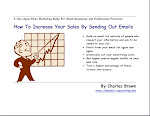A New Strategy For SEO Writers – The SEO Press Release
Posted by Charles Brown at Sunday, June 22, 2008A Review of Chirstine O'Kelly's ebook, "How to Write Optimized Press Releases"
I've been an SEO writer for three years now and I am still learning new search engine optimization tips. My latest learning experience came from reading Christine O'Kelly's ebook, How to Write Search Engine Optimized Press Releases, which she offers at her website, www.selfmadechick.com (the ebook is free, all she asks is that you subscribe to her RSS feed in exchange for the download).
The first point O'Kelly makes is that with so many online press release submission sites, it makes sense to send out releases not only to get favorable mention in the media, but also for the inbound links from the submission sites themselves.
In this regard, an SEO writer would not only be writing for a human audience, but for search engine robots as well – similar to submitting online articles to sites like www.ezinearticles.com.
Each submission site enables other online and offline media to pull the press releases for publication on their own sites, providing the opportunity for an SEO writer to create viral distribution of each release.
But even if a press release is not picked up by any other source, the submission site itself will often have a high page ranking and will point back to your site.
The second point O'Kelly makes is something of a surprise, but I think she is on to something here.
SEO writers are often faced with a conflict between writing keyword-dense headlines and writing headlines that humans find irresistible to click.
She says that given a choice between writing headlines that will persuade human readers to click your link, or to fill the headline with keywords to attract a search engine, the SEO writer should choose the keywords first. In her own words, "if you have to choose, pick keyword over clickable."
She supports her keyword-first approach by pointing out that the human reader will not see the link if it does not get a good ranking.
Fortunately, she then solves the need to get humans to click on the links by suggesting that a subtitle be added to the press release that is designed to get clicks. A neat solution to a consistent problem.
Her third point is to write an SEO, keyword-rich summary for each press release. This summary is often reprinted in the search results for the human reader to see, with the keywords in bold text. And of course it is also another opportunity for the search engines to pick up the theme of your release and rank it accordingly.
The final point (note: O'Kelly doesn't say this explicitly, but this is a point I took away from her book) regards an old habit I may now have to break.
I've always held to the notion that press releases should really hit the "newsworthiness" button hard. In other words, in the offline world, you don't want to get the reputation of wasting an editor's time with trivial press releases.
But with online press releases submitted to submission sites, this is not quite as demanding a standard.
This is not to say it is okay to submit a lot of junk, self-serving press releases that have no hope of ever being picked up by other media sources. But it does broaden the scope of what is, and what is not, newsworthy.
A new product or service, a new published report or ebook, a newly hired executive or partnership, might all become good topics for press releases.
As I read Christine O'Kelly's ebook, I was more than a little surprised that she is giving it away free of charge. I highly recommend it to any SEO writer or webmaster who is looking for more ways to get targeted traffic to their websites. Check it out at How I Ranked in 5 of the Top 10 Search Results in Google.
COPYRIGHT © 2008, Charles Brown

Labels: headlines, keywords, press releases, SEO press releases, seo writing
Subscribe to:
Post Comments (Atom)



0 comments:
Post a Comment